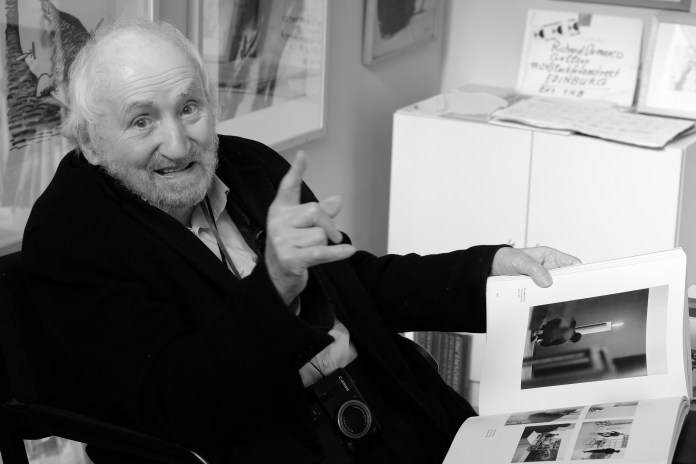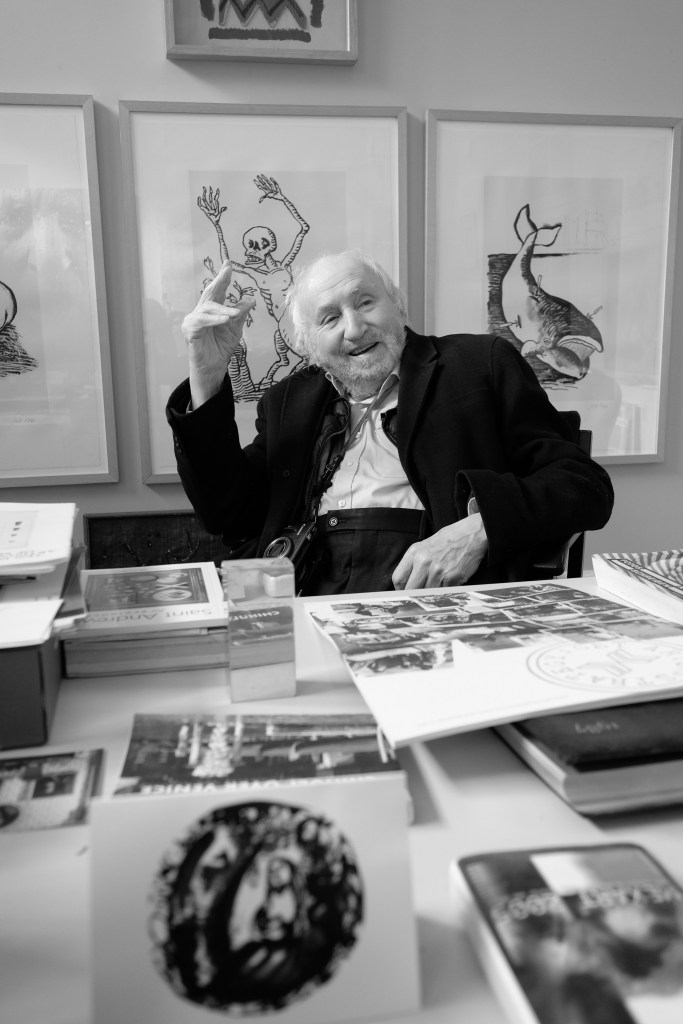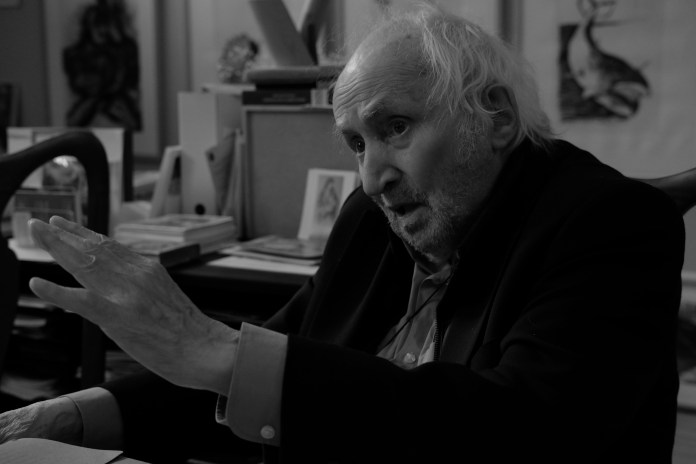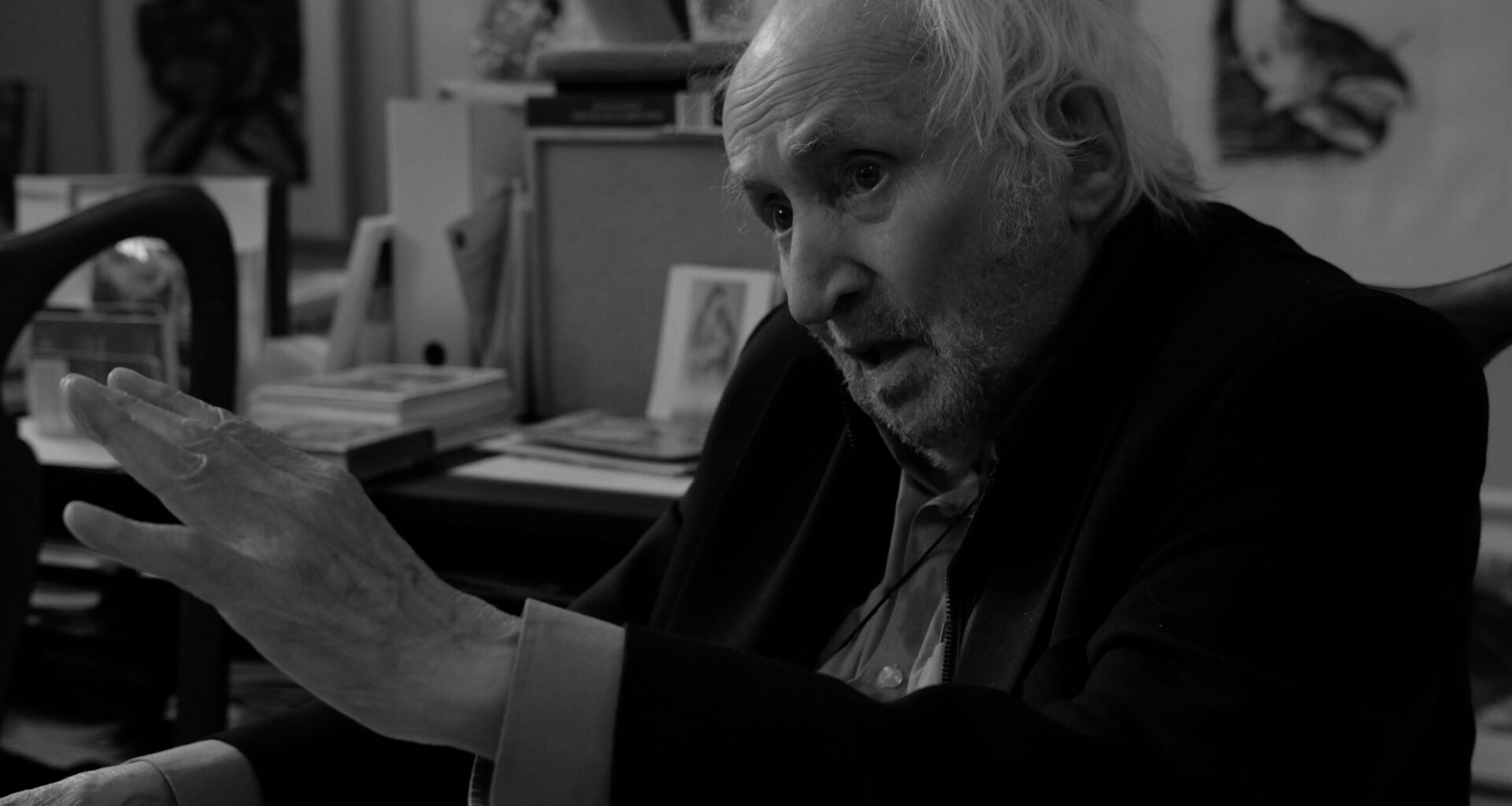Now aged 95, Richard Demarco, CBE, is very aware he is on the final leg of his life of cultural exploration.
He is hoping though that his cultural life still has one final journey, one final pilgrimage. In a long conversation earlier this year, Demarco outlined what lies ahead for the physical manifestation of his cultural life, his archive, his ‘Gesamtkunstwerk’ (a universal artwork).
This it seems is destined to leave Scotland – and find a new home in the heart of Europe. This is fitting given Demarco’s long expressed view that there is “no such thing as Scottish art, only art in Scotland which is part of a European tradition”

Unending cultural dialogues
His physical frailty was evident as he made his unsteady way up the steep steps from his basement flat, but also his determination to keep going. A sense of much still to be done. This is what propels him up and onwards. Our conversation was very nearly cancelled. The day before I was due to talk to him, his wife suffered a stroke and was taken to hospital. Told that she was unable to take visitors for several hours, Demarco decided to go ahead, keen to take advantage of every opportunity to communicate his message.
His packed schedule includes multiple meetings and engagements, all with the aim of connecting to those who can assist with his final project, his final journey. The intensity of these efforts has gone up a gear in recent months, as detailed in his regular newsletters, which summarise his continued cultural dialogues and contextualise their significance. Something that gives him a little more optimism at present is genuine hope that his vast archive, housed at Summerhall, may have a secure home. Nothing is yet settled but there seems more than hope that what he has put together will have an appropriate resting place, where it can be properly accessed and assessed by researchers. But, this proposed new home is not in Scotland.
Where’s it all going?
Despite their best efforts, The Demarco Archive Trust has not been able to find a Scottish institution willing to take it on. Cuts to the finances of The National Galleries means it is no longer an option for them. Also, they already have a sizeable amount of material from Demarco, bought from him in 1995. They can’t also take the material currently stored and displayed across 13 rooms of Summerhall, including a portion of stuff in a cluttered basement area. Demarco also has sizable chunks of material in his home near Dean Gardens and in his studio in the peaceful countryside of Midlothian. Where’s it all going?
The institution that seems most likely to take it is MS in Lodz, Poland. While I was with him Demarco was going through a long, detailed email from his lawyer, setting out what needs to be in place, legally and financially, before any contract is signed. The likely location would be a restored ex-hospital, a fitting place given Demarco’s view that art offers a “healing balm” to our ills, psychological and physical. That, without artistic release, we become a potential “menace” to society.

The last man in Europe
It seems fitting that on his final leg he will again be crossing borders, into the heart of Europe. Cultural journeys and cross national cultural dialogues have been at the heart of Demarco’s long cultural life. While there is regret that his archive will leave Scottish shores, it will be a final manifestation of his profoundly European identity. Consistently, he has rejected the label of a purely Scottish artist or cultural figure. “I have never been anything but European”.
This European aspect is manifested in his many collaborators from central and Eastern Europe. These cultural dialogues and alliances are prominent at Summerhall, where the art and collaborations with Romania, Germany, Poland etc are represented in different rooms. Trips to these countries were some of his most significant cultural journeys, so it will be appropriate if his final one is to the heart of Europe, to a country again besieged by the type of existential threats that have so haunted Demarco since his war-blighted childhood. These include incipient authoritarianism, represented by Russian and the surge of reactionary populism, from which Poland has not been immune.
Demarco’s cultural journeys to Eastern Europe were a manifestation of his desire to work with those imprisoned by authoritarian regimes, using their art to express their inner freedom. As someone who grew up in an era of authoritarianism, Demarco feels this aspect of history re-emerging with a vengeance. This sense of continuity between the past and present is represented by a recent exhibition, at the University of Stirling, on George Orwell’s 1984, The Winston Smith Library of Victory and Truth by artist Hans K Clausen. Demarco found Clausen’s work both powerful and timely.
Defending true Western values
This visual art installation consists solely of one novel made up of 1,984 copies of George Orwell’s 1984, sourced from around the world. It represents the way the book, by a writer seen as very English, has reached a worldwide audience. The modern editions illustrate its ongoing resonances. The aim of the exhibition is to “affirm the timeless power of human storytelling to transcend borders, cultures and ideologies.” To put it another way, while Orwell’s political and cultural essays still contain resonance, it is his two great creative works of fiction (Animal Farm and 1984) that are best able to connect to new generations.
The exhibition has been on Demarco’s mind ever since. For him, it is a prime example of art that connects to the “central questions of the age”, which is what he wants to see more of. Too often, believes Demarco, artists focus on trivial subjects. There is, he believes, a meaninglessness about much contemporary art. It’s “not profound”, little behind it, “nothing substantial”. He connects this to the threats impinging on Europe at present. The Ukrainians are, Demarco puts it, fighting in a war which is “senseless” but far from meaningless. “Artists don’t take this seriously-they must”. Demarco often quotes the distinction, made by the American cultural critic Dore Ashton, between artists as tourists versus artists as explorers. For Demarco, which many claim to be artists, a substantial number are merely playing at it as cultural tourists. Too much culture is essentially entertainment rather than something of serious intent. In the present moment, artistic endeavour must be part of a wider fight against totalitarianism, defending true Western values.
Nature and art
1984 was, famously, largely written at Barnhill on Jura, where Orwell sought clear air as he battled the tuberculosis which would soon kill him. Escaping the noise, smog and damp of London, he rushed to get his warning to the world completed before he ran out of time. Demarco is aware that he is facing a similar predicament as he battles to ensure that the cultural vision manifested in his archive lives on. Demarco’s legendary levels of energy are on the wane. On the journey to his studio, warm sunshine drifting through the car window Demarco’s narrative slows and then stops (“he’s allowed the odd nod off”). Five minutes later, he was off again, waxing lyrically about the countryside we sped through.
Demarco is not surprised that Orwell was inspired by Jura. For Demarco, the dramatic landscapes (and the particular light) of northern Scotland and its isles cannot fail to inspire cultural creativity. The tale of Orwell’s time on Jura is vividly told in Anna Funder’s dashing Wifedom, about Orwell’s ‘invisible’ first wife Eileen, overlooked by most biographers. Funder depicts Orwell in Jura as “at the edge of the known world” fleeing his day to day concerns and sitting “typing and smoking” with a view out to the sea. Jura is known for its stunning views, including to the ‘paps’ – vistas that have inspired many artists.
These will have surely inspired Orwell, even as he battled severe ill-health. Demarco has long taken inspiration from nature, including remote, rugged places. Some of his own drawings of rural Scotland feature in Demarco’s Scotland (Luath Press, 2024). This was one reason he brought so many artists to Scotland, encouraging them to explore the country well beyond its metropolitan centres. Throughout his cultural life, he has seen a direct connection between art and nature. As he looks across to the Pentlands from the lounge of Terry Ann Newman’s cottage, sunlight trickling in through the window, he exclaims, “I’m all about explorations, going to places and experiencing them”.
The Polish connection
For Demarco, 1984 retains vital relevance. He hopes to see the exhibition presented in other countries. The continuing relevance of 1984 was also made clear to Demarco when viewing an adaptation at the 2024 Edinburgh Fringe, performed by Ukrainian and Belarusian actors. For Demarco, such countries, Poland included, are “on the front line” in terms of defending freedom, democracy and Western values more broadly. Artists in these countries, believes Demarco, must play a central role in this effort.
The experience of Poland in the 20th century is, for him, the clearest example of the ravages of tyranny, having suffered Nazism and Stalinism. However, the country’s ability to survive and flourish gives him further hope. Even its recent electoral rejection of the radical populist right is a cause for optimism. It makes him wish to stress the deep connections between Scotland and Poland. For instance, Bonnie Prince Charlie was half-Polish on his mother’s side. These links were recently outlined by a speech in Edinburgh by Piotr Wilczek, Polish Ambassador to the UK.
Enduring cultural ties
Wilczek spoke of the “enduring cultural ties” between the countries, deepened during the Second World War, when many thousands of Polish servicemen were based in the country, under the command of Generals Maczek and Kukiel. This is commemorated in many places in Scotland including General Maczek Walk on Bruntsfield Links. It shares the park with Muriel Spark Walk. The path was opened in 2018 by the journalist and crime writer Olga Wojtas, daughter of a Polish soldier who settled in the UK after the Second World War. Maczek did the same, living in Marchmont until his death in 1994, aged 102. Given all the unfinished tasks and projects Demarco has, he must hope to live to a similar age.
According to his son, Maczek felt as passionate about Scotland as his native Poland. Certainly members of the Polish Resettlement Corp formed the basis for much of the Polish community in Scotland and the UK today. For Demarco, the way that this generation of Poles enriched Scottish life, connects to his own life story and his sense that great things, such as the Edinburgh Festival, can come out of conflict.
This connection has been deepened by the influx of Poles into Scotland since Poland gained EU membership in 2004. Wilczek spoke of the “significant contribution” by Poles to Scotland’s “academic and economic landscape”. Wilczek hopes that Polish people, with their “work ethic and dedication to excellence” will continue to be an “integral part of Scotland’s social fabric”. For all these reasons, Demarco feels that Poland is not really a foreign setting for his archive but a place umbilically connected to Scotland, part of his quasi mystical Road to Meigle Seggie. Demarco hopes that housing his archive in the heart of Europe will further cement these connections into perpetuity.
A drift away from seriousness
Demarco is renowned for his sweeping statements and impassioned appeals. These are fuelled by the wounds of childhood. These included his sense, as an Italian and a Roman Catholic of feeling marginalised. Increasingly prominent in his conversation are religious themes. Partly from the religiously inspired art by his long-time assistant Terry Ann Newman, whose cottage is often where he is based – in a studio in her garden. He increasingly talks of the need to revive the idea of Christendom as a motivating idea for artists. More broadly, that they are part of something significant, beyond the narrow experiences of their own lives. This is in part because artists don’t seem to be motivated by the deepest question. When he looks at the great works of art, it’s clear that they are working at a very profound level, marked by “ineffable mystery”.
A general drift away from seriousness is, Demarco believes, evident in the changing character of the Edinburgh Festival and Fringe. He’s no longer convinced that Edinburgh is the place of cultural pilgrimage it once was. He relates that, as he is “one of the last human beings alive who can recall the first festival”, he can “speak with authority about it”. Specifically, he can relate the sense of wonder that the event formed in him. As a 17 year old, he was blown away to discover that something so profound and sublime was happening in his home city.
Its aim to heal the deep wounds of war also connects with his profound ‘Europeanness’. During the Festival, he no longer felt like an outsider. He is one of the last of that Italo-Scot generation who had to suffer for being who they were. Italian Scots continue to have a significant impact on our culture, notably Nicola Benedetti, now head of the Edinburgh Festival. Demarco has been impressed by her efforts, but remains sceptical about the contemporary ‘iteration’ of the Festival and Fringe.
Final act

One of Demarco’s ongoing projects is getting the biographical aspects of his life in an ordered form. In his living room, here surrounded by ring binders, full of material relating to key aspects of his cultural life. Getting these in order is the project he is focusing on, while also involved in efforts to find a secure home for his vast archive. It feels like he is putting his life in order, aware that the vastness of what he has collated can obscure the key themes. The folders are rich in fascinating material and also an aesthetic pleasure. Some of the programmes and posters are beautifully produced, works of art in themselves. It’s an example of the cultural riches that he has collated. If the agreement with MS is signed, it would be Scotland’s loss, but Europe’s gain.
He is transcribing key parts of his early years making use of the detailed diaries he has kept since his schooldays. In these he connects what was happening in his life with the wider context. These binders contain “aspects of my most profound activities, as I approach the end of life”. The childhood period covered in the binders is intermingled with the events of war time, a period that has shaped his life in many ways. For Demarco, his artistic life and cultural exploration has been fuelled by the deep scars of war. This underscored the profound seriousness of cultural endeavour.
No doubt, he is ever more prone to repetition; but in a sense his message is becoming more focused, getting to its essence. This need to articulate his core themes fuels each day. He sees Europe at a similar crisis point, with existential threats looming large. Demarco wants contemporary artists to understand the profound nature of their activity. He wants them to engage with the deep questions facing us.
It’s time to get serious.
Like Loading…
Related
